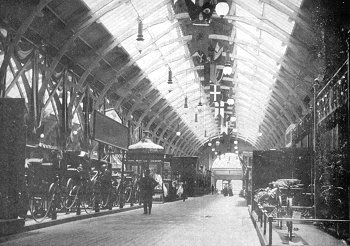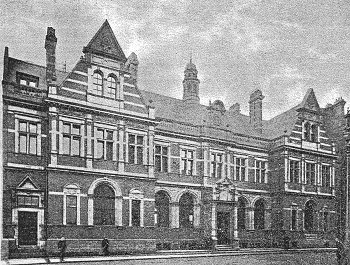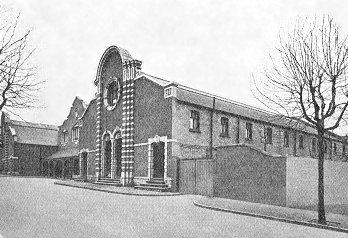|
Wolverhampton in the 19th Century
At the time of the
Queen’s accession, Wolverhampton was a prosperous town, owing
its wealth not just to industry but also to the fact that it was
an important agricultural centre and market town, a mixed
economy town if ever there was one. Writing in 1839 one observer
commented:
“The town is on the
western borders of the mining district, and the neighbourhood
consequently abounds with mines of ironstone and limestone, with
furnaces, gorges and iron works. There is also a corn mill, two
worsted mills and chemical works for the manufacture of
sulphuric acid and nitric acids.
The trade of
Wolverhampton is greatly facilitated by its situation on the
direct line of the road to Holyhead, Manchester and Liverpool.
It also has the advantage of navigable communication to every
part of England by means of the Birmingham Canal”.1
The diversity of industry
in the town was one of its strengths and the list of trades
practiced must rival in sheer diversity any other town in the
country. The manufacture of japanned and tin ware was introduced
into the town from south Wales in the 18th century. Together
with Bilston, Wolverhampton was at the centre of this industry
and produced goods for home and foreign consumption. Although we
now tend to associate the manufacture of locks with Willenhall,
Wolverhampton too was an important centre for the industry but
one that tended to make more expensive products. The Chubb
Brothers, Charles and Jeremiah, first made locks in Portsea and
later moved to Horseley Fields in 1818. Later they moved to the
finest industrial premises in town, the Chubb Building.
|

Locally made products on display in part
of the interior of the Industrial Hall at the Wolverhampton Art
and Industrial Exhibition of 1902. The displays reflect the
confidence and prosperity of local manufacturers at the time. |
Tubing was
made for gas and locomotives and steel works of every
description from nutcrackers through files, rasps, vices, and
anvils to cycles and tricycles. Coach ironmongery was made, as
was kitchen furniture. There were also grease, chemical and
varnish works, malting and brewing, corn mills, and cooperages,
iron and brass foundries. There were no less than ten spectacle
manufacturers not to mention snuff grinders and watchmakers.
There were also many patent articles manufactured in
Wolverhampton including enamelled saucepans and other culinary
utensils “coated on the insides with a sort of porcelain
instead of tin”. |
|
The many fine Victorian
buildings in Wolverhampton are testimony to the prosperity of
the town in the 19th century. Its population in 1831, six years
before the accession of the Queen was 24,732. This can be
compared with the 6,647 of Walsall and the 37,000 of Stoke on
Trent. Between 1801 and 1901 the population of Wolverhampton
increased eight fold.
*
*
*
*
Despite the fact that
much of Wolverhampton is Victorian, the town still has something
of the townscape of a medieval market town. The market was south
of the church and the names Exchange Street and Cheapside gives
away its origins. Victorian Wolverhampton was slow to develop.
“Look at the town…Few
in England wear seemingly more antiquity in general aspect. Here
are houses built in Elizabeth’s day… Its name has a good old
Saxon sound; and its main street and market place have not yet
been reduced to the straight lines and cast-iron uniformity of
modern architecture”.2
It is interesting to note
that one of the old Elizabethan buildings mentioned by the
American writer Eliash Burritt* was the Old Hall on the site of
the present library. A firm of paper makers and japanners used
this until the early 19th century. The hall had been the moated
mansion of the Levesons, a family who had made their money
through the wool trade. In the 18th century Joseph Turton
junior, an iron factor, purchased the hall and removed the upper
storey and inserted sash windows. The hall later became Turton’s
hall. In the 1860s it was still used for industrial purposes by
F. Walston & Co. It is a pity that the hall has not survived, as
it would have be a rare and interesting example of a country
house converted to industrial use.
Like many industrial
towns, the rapid development left the local authority helpless
in the face of fast multiplying slums and the attendant problems
that they brought. As late as 1842 a Government report on the
slums of Wolverhampton read: -
“In
the small and dirtier streets, at intervals of every eight or
ten houses…the great majority are only three feet wide and six
feet high…These narrow passages are also the general
gutter…having made your way through the passage, you find
yourself in a space varying in size with the number of houses,
hutches, or hovels it contains. They are nearly all
proportionally overcrowded”.3
*Burritt is often credited with coining the appellation Black
Country, but the name pre dates Burritt by many years. The
people of Stratford Upon Avon have never forgiven Burritt for
linking them with Birmingham.
The
industrialization of the area and the concomitant loss of
greenery were noted by a German visitor in 1835.
“About Wolverhampton, trees, grass and every trace of verdure
disappear. As far as the eye can reach, all is black, with coal
mines and ironworks”.
Others were not so dismissive; the following writer (1851)
refers not only to the improvements taking place in the town,
but also to its quite magnificent settings:
“(The
town) is very salubrious…being seated on the summit of a bold
gravelly eminence…skirted by fertile pastures and gardens, and
having in the distance hills of great magnitude. Until about
twenty years ago, the town displayed but little beauty in its
streets and buildings”.4
There were some areas that
were particularly bad including Lower Stafford Street, Salop
Street, Horseley Fields and the Bilston Road area. Even as late
as 1865, £100 was granted to the Sewerage Committee to meet the
expense of covering over the public ditches. In a report on
Wolverhampton in “The Builder” of August 1872 the writer notes
“the most odious court system, countless courts of the most
unhealthy and objectionable character…with middens full,
stinking and confined, and deadly”.
The writer points out
what to us must seem surprising, that is the close proximity in
which the well-off lived to areas of utter squalor; he ends on
an ominous note:
“In Peel Street and its
neighbourhood and in what is called Caribee Island, the
condition of things is frightful: if the latter were really the
settlement of a tribe of wild Indians, it would be an object of
wonder to the civilized upper classes of Wolverhampton. These
are places which fight against the general salubrity of the
town, and out of which will one day come some frightful epidemic
to dispel the security at present indulged in, and rouse to
salutary action”.
The
poor housing was often not just a health hazard but a physical
danger as well. In 1876 a number of dilapidated houses in
Walsall Street collapsed killing a boy, one Edwin Brown.
|
| Like many
large towns, Wolverhampton took advantage of the Artisans’
Dwelling Act of 1875. This (Conservative) measure passed by the
Government of Disraeli, empowered local authorities to pull down
slums and rebuild decent accommodation for working class
families. In Wolverhampton there was a scheme to clear and
redevelop the area between Queen Square and Stafford Street.
This was the notorious Caribee Island area. The intention was to
provide suitable habitation for the displaced and land at
Springfield was purchased for that purpose. The Act was
implemented in 1881, when much of Lichfield Street was
re-aligned to provide a street of metropolitan grandeur. |

The new post office in Lichfield Street,
which opened on 29th March, 1897 is typical of the imposing and
attractive Victorian buildings that were appearing at the time. |
| The first
shop in Lichfield Street opened in 1883 and building was
completed with the Grand Theatre in 1894.
It was reported in 1818 that
the streets leading off Queen Square were substantial and well
built. The town was paved and well lit by gas. However prior to
this, one of the main problems for Wolverhampton had been the
maintenance of an adequate supply of water. Water was supplied
to Wolverhampton by wells sunk to a great depth under the rock
upon which the town was built (indeed, Banks’s Brewery still
uses one of these pure artesian sources). However this water
supply was inadequate for the needs of the expanding town and so
to supply this need a company was formed and an Act obtained in
1845 for the erection of a waterworks, which was opened in 1847.
The water was obtained from springs in the red sandstone rock at
Tettenhall and Goldthorn Hill where storage reservoirs able to
hold 2 million gallons were constructed. From these reservoirs,
water fell through 15-inch pipes, which were constantly charged,
so that in the event of fire, hoses could be attached to throw
water over the highest building. Water was also obtained from an
artesian well at Cosford. It was reported that the water in
Wolverhampton was remarkably pure and soft. These wells still
supply water to the town.
One of the ways in which
the health of the nation was improved was by the erection of
public baths and in this Wolverhampton was no exception. The
architect G.T. Robinson designed baths built in multi-coloured
bricks in bath Street. There were hot, cold, tepid and vapour
baths. The self-improvement that was such a feature of life at
all social levels was also in evidence here for attached to the
baths were reading rooms and rooms for chess and other
amusements.
|
|

The Municipal Swimming Baths.
|
Despite the fact that
Wolverhampton was a major industrial town, we should not forget
that it was also a major market town. The numerous “Folds”
around the church are an indication of the importance of the
town as a medieval market. The nearby Halfpenny Green is a
reminder that here, cattle driven from Shropshire, were fattened
up at a halfpenny a head before being driven to town by way of
Salop Street.
|
|
As
was noted in 1876:
“Few,
if any, large manufacturing towns possess so large an element of
agricultural interests. The weekly market, which takes place on
Wednesdays, is largely attended by farmers of the county, and
also by those of the sister county of Shropshire and an enormous
quantity of cattle is disposed of and finds its way to the
shambles of the metropolis, as well as to those of the immediate
district”.5
(The word “shambles”, as used here, is the old name for a
livestock market).
In White’s Directory of 1861
the writer could say that Wolverhampton was “the most
populous borough and market town in Staffordshire”.
Many buildings serving
primarily agricultural purposes were witness to this unusual
combination of industry and agriculture. (The Royal Agricultural
Society held their 1871 show in Wolverhampton). An open market
was once held in Queen Square, formerly High Green. The modern
buildings of the Square still outline the ancient market area.
Before the erection of the cattle market, animals had been
driven into the town and sold openly on the streets, “often
to the annoyance of the public and injury to the beasts
themselves”.
The cattle market, designed by Edward Banks, was situated in the
Cleveland Road near to St George’s Church. It was thoroughly
well drained and had an abundant supply of water. Its capacity
for some 700 horses, 5,000 sheep and 3,000 pigs gives some
indication of its importance as a livestock market. The
delightfully named Fat Pig Market was situated in Bilston
Street, adjoining the Cattle market. This was opened in 1856 and
had accommodation for about 800 porkers.
The agricultural side of
the town’s activities is shown by the erection of an
Agricultural Hall in 1863, which occupied a prominent position
on Snowhill. A large moulding showing a plough and a sheaf of
corn surmounted the entrance. It was later used as a corn
exchange and for the display of agricultural implements. In its
open space of 1,200 sq yards, there were held flower, poultry
and dog shows. The recently demolished Gaumont Cinema occupied
the site of the Agricultural Hall. The cinema and the present
shop on the site both follow the contoured outline of the old
Agricultural Hall.
Few people in Wolverhampton
could fail to be aware both of the close proximity of the
countryside and the novelty of industry occupying former
agricultural land. One of the main complaints about St. Mark’s
Church in Chapel Ash, was that although the view from Queen
Square was impressive, it blocked out the vista of the Clee
Hills and Shropshire. It was also written of Horseley Fields, (a
ley for horses), that it is “but…now redundant in smoke, and
the noise of the forge and steam hammer is heard, where formerly
the lowing of cattle and the bleating of sheep were the
prevailing sounds”.6
Politically Wolverhampton came into its own after the passing of
the 1832 Reform Act. By this Act Wolverhampton was allowed to
send two M Ps to Westminster. The first two men who had the
honour of representing the town were Charles Villiers and Thomas
Thornley. Under the Redistribution of Seats Act of 1885, the
number of seats was increased to three. The constituency also
included Willenhall, Bilston and the parish of Sedgley. In 1848,
under the terms of the Municipal Corporation Act of 1835, the
town received a charter of incorporation. By this the town was
governed by a Mayor, twelve aldermen and thirty-six councilors.
The town was divided into eight wards, a further four being
added in 1896. From its incorporation, Wolverhampton council
acted with vigour and enthusiasm that was the hallmark, though
not the prerogative of the new industrial towns.
There was vigorous political
activity in the town with numerous political and social clubs.
In 1889 there were three Conservative Clubs, one being for
Conservative Working Men, and two Liberal clubs including the
Villiers Reform Club. As an expanding and prosperous town, with
a secure artisan class, there were quite a number of
institutions to help those of an industrious nature to rise in
the world, that social mobility so beloved of the Victorians.
Among the provident institutions of the town were a savings bank
and a number of friendly societies. The Wolverhampton Freehold
Land Society was established in 1848, for the purpose of
enabling working men and others to obtain plots of freehold
building land and thus become entitled to vote in parliamentary
elections. Initially 1,200 shares were issued to 750 individuals
with which land was purchased in Moorfields and Sedgley Road.
Also the society entered into an agreement for the purchase of
Whitmore Reans estate for £8,000.
All in all, the picture
of Victorian Wolverhampton is one of improvement, wealth,
energy, pride and redevelopment and this is reflected in the
many buildings of the town.
The term “Victorian” is one
of the most widely used descriptive words and also one of the
most imprecise. We speak of “Victorian values”, “Victorian
Architecture” and the progress of the “Victorians”.
Notes:
| 1. |
W.G. Hoskins, "The Making of the English
Landscape". |
| 2. |
Eliash Burritt, "Walks in the Black Country
and its Green Borderland", 1868. |
| 3. |
Factory Inspector's Report, 1842. |
| 4. |
White's Directory, 1851. |
| 5. |
Steen & Blackett, Wolverhampton Guide 1871. |
| 6. |
ibid. |
|
 |
|
 |
|
 |
| Return to
19th Century Britain |
|
Return to
the contents |
|
Proceed to
Victorians
and Architecture |
|